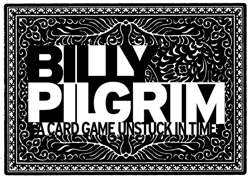 One of my goals for 2011 is to make significant progress towards publishing my first non-digital game. So as this year moves forward, I’ll be putting more and more thought into designing Billy Pilgrim, my tentatively-titled card game about love and unintentional time travel.
One of my goals for 2011 is to make significant progress towards publishing my first non-digital game. So as this year moves forward, I’ll be putting more and more thought into designing Billy Pilgrim, my tentatively-titled card game about love and unintentional time travel.
What feels like a hundred years ago, I talked about playing cards — ubiquitous decks of 52 which comprise the toolset of countless games. I’ve known from the beginning that Billy Pilgrim was meant to be a card game. As vehicles of widespread gameplay, cards are undeniably important. But I think it’s easy for us, as players and creators, to forget what cards do.
Cards and dice are both vehicles of randomness. But with dice, there’s no shift in probability as the game draws on. Dice represent a stasis in the degree of randomness in the world. And when we play with dice, we don’t seek to derive order from the chaos. We simply seek a means to represent unknowable factors.
Cards, on the other hand, are agents of turmoil. The odds change with every play, every turn. And most card games — at least those built upon a standard playing card deck — are all about creating organization from a disorganized pile.
So for making a game about a non-chronological character, there’s no better tool than cards. The question remains, however, as to whether or not as a player we seek to help Billy find order in his world, or whether we are merely observers of a scattered story, trying to find order for ourselves.
2 replies on “What cards do.”
Hi, Scott. I haven’t followed you in a while, but it’s nice to see you’re still going, and working on an analog game, no less.
Keep us posted.
Yehuda
Thanks Yehuda! Going to try and get back into a regular blogging pattern. Lots of fun stuff going on these days.
I’ll try not to disappoint!